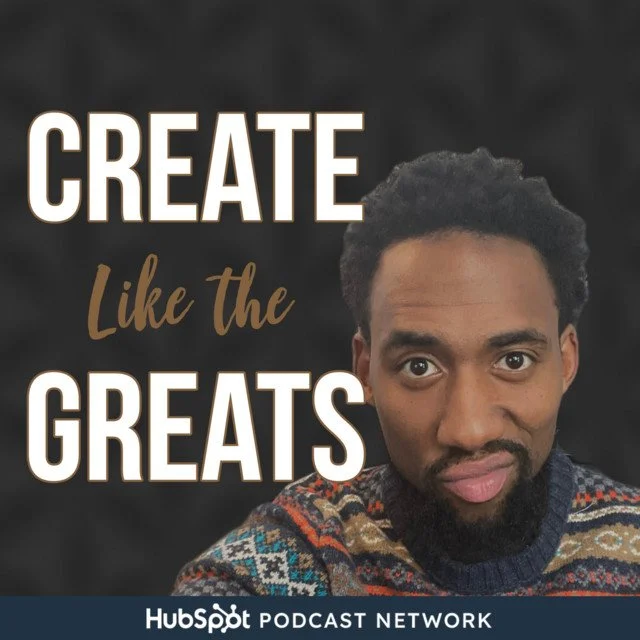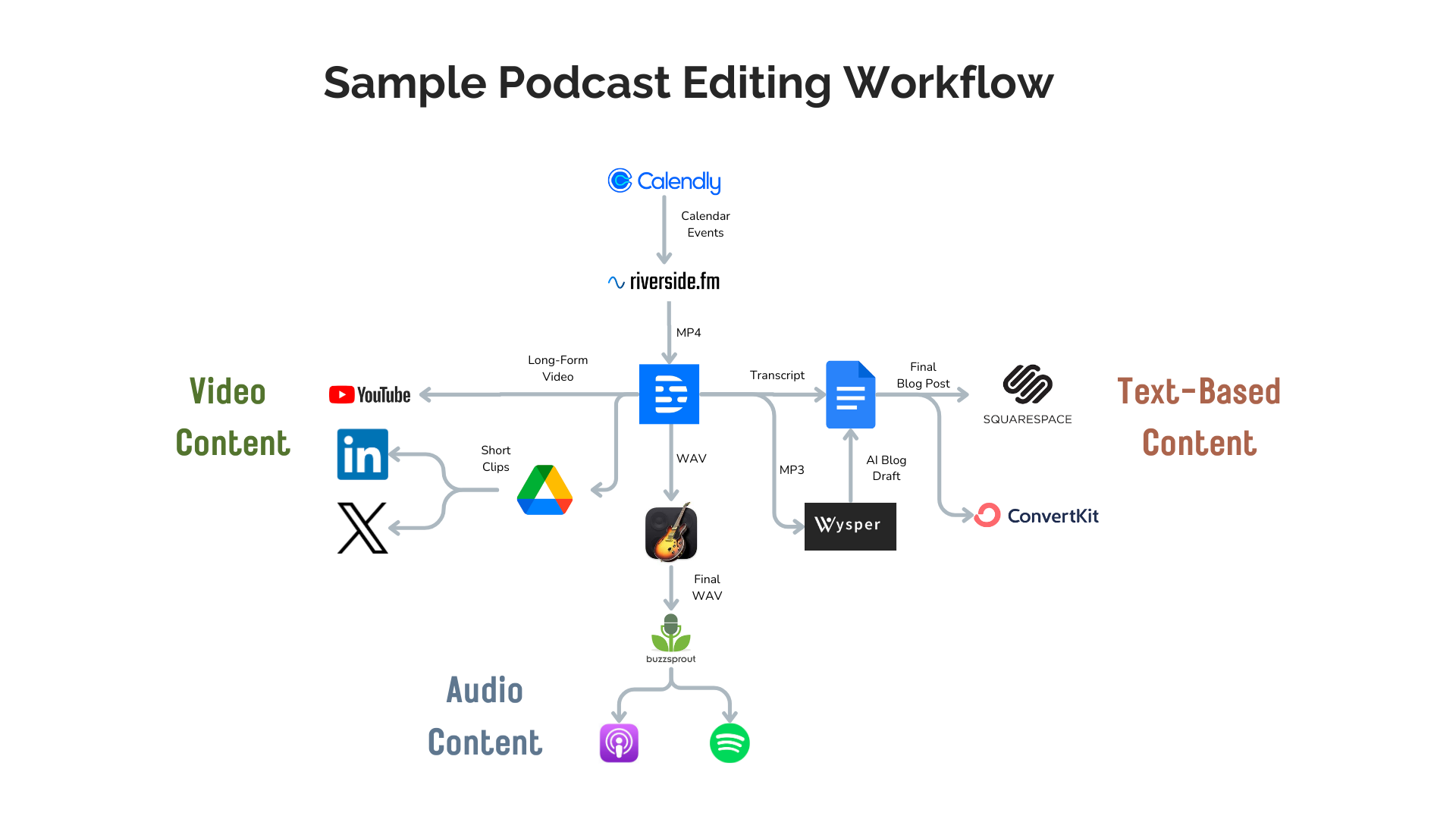Create Like the Greats: Podcast Distribution Tools and Frameworks, with Ross Simmonds
Besides word-of-mouth, how are you growing your podcast audience? Let’s be real… With flooded social feeds, do you really think one LinkedIn post for each new episode of your business podcast is going to be enough to move the needle? Maybe it’s time to level up your podcast distribution game. In this article, you’ll learn how to distribute a podcast for your professional services firm from one of the greats.
Recently, I had the pleasure of chatting with Ross Simmonds, Founder & CEO of Foundation Marketing, and Host of Create Like the Greats podcast. I’ve been following Ross for a few years now. His mantra, “Create Once Distribute Forever” is etched in my brain and has absolutely influenced my approach to marketing.
In this episode, Ross shared his experience podcasting, experimenting with AI, a podcast distribution workflow he uses for his show, and so much more. Listen to the full conversation here:
Create Like the Greats: The Ross Simmonds Audio Experience
Experimentation has always been a the heart of Ross Simmonds’ marketing philosophy. For example, he recently tested out a way to create video by feeding an AI avatar a text prompt. We had a good conversation about this kind of technology and its impact on podcasting and trust in the marketplace. Here’s the video Ross made:
Having been a content creator for decades, it was only natural that Ross would eventually start a podcast. In 2022, Ross launched his podcast with the encouragement of his team and peers.
“We have so much great content that I've written research that I've done on some of the greatest businesses of all time. Why don't I turn this into an audio experience for people?” thought Ross. “I had bounced the idea around with a few folks, and people thought, yes, this is a good idea. We went full speed ahead. Fast forward 100,000 downloads later and it was a success.”
Journal Entries: A Window into the World of Ross Simmonds
The marketing benefits are tangible and the podcast has made an impact on Foundation, but the benefits of the podcast go beyond the business. The podcast gives Ross an opportunity to give his listeners a window into his world with episode types he calls “journal entries.”
“Personally, I get a ton of joy out of these conversations and also giving people a glimpse into my world,” said Ross. “There's a subsection of Create Like The Greats called journal entries and in these journal entries, I take people behind the scenes into the problems I'm facing, the challenges that I'm trying to overcome, experiments that I'm running, events that I'm attending, decisions that I need to make, all of that stuff. I give people that inner look into my world.”
The Future of Create Like the Greats
At the time of my interview with Ross, he had just north of 60 episodes published. I asked him where he planned to take the show from there.
“I think we want to do more of those in depth breakdowns,” said Ross. “We want to interview some other great creators, some people who are doing some interesting things in the space.”
Ross also brought up doing more of the journal entry episodes, and used his new book as an example: “I'm working on right now writing a book. And I want to get an episode up very soon that talks about what that process has been like and what the struggles were, the challenges were, where we are today, where it's going, all of that stuff. I want to start giving people more of that type of material and that type of content so they can follow along the journey as I go through this wild thing called entrepreneurship.”
If you’re a content creator or marketer in B2B, Ross is an absolute must-follow. The rest of this article will focus on some of the core principles behind his mantra, “Create once. Distribute forever” as it applies to podcasting.
What is podcast distribution?
Podcast distribution refers to the practice of packaging podcast content to be consumed natively on individual channels. It is not as simple as directing traffic to your full podcast episode on Apple or Spotify. Rather, the intent is to spread the ideas and messages conveyed in the podcast through video snippets, blogs, LinkedIn posts, X posts, emails, and more.
“When you press publish on a podcast, the most important thing you can do is not to just hit submit and call it a day,” said Ross. “It's to actually amplify and promote the podcast that you just did. Find good clips from within that podcast, repurpose them, reshare them, share them on X, share them on LinkedIn, share them on Facebook, share them in your story. You want to repurpose these things that you're creating.”
Example of Podcast Distribution from the Buyer’s Point of View
For example, imagine you offer tax advisory services to business owners of franchise restaurants. One day, you stumble across a 30-second video snippet on LinkedIn about how to structure an offer enticing enough that your buyers will actually take action. You watch the video clip, say “hmm” to yourself, but you do NOT listen to the podcast.
A few weeks go by. You remember what you heard in that LinkedIn video. So you search for the host’s name + the topic of the episode. Lo and behold. In the search results, you find a blog post that has a video, the podcast episode, and written content outlining everything and more you wanted to know based on that one LinkedIn video. You read the blog, but you do NOT listen to the podcast.
After letting it sink in a few days, you decide to reach out to learn more about how they can help you structure an offer to accelerate lead generation for your accounting practice. Without listening to a single podcast episode, a lead reached out after consuming podcast content 🤯
How to distribute a podcast like the greats
Pressing publish isn’t the finish line. It’s where the next phase of work begins. In this section, we’ll take a look at podcast distribution roles, frameworks, and amplifiers.
Podcast Distribution Frameworks
The sheer volume of potential content that can be produced from a single podcast episode is astounding. And overwhelming. Which is why it’s critical to have a podcast distribution framework to stay organized. Below is a high-level visual of how a podcast can fuel audio, video, and text-based content.
Below is a podcast distribution flowchart I use for my own show, Podcasting in Professional Services. I detailed a breakdown in a recently newsletter edition, also in this blog post about podcast editing workflows.
Ross’ workflow is slightly different. He takes an audio-first approach to the podcast content, and looks for signals that tell him which episodes he should seek to get more dividends from.
“Once the episode is created, we have an asset,” said Ross. “And if it is one that actually takes off, we're going to turn it into a video.” Ross’ videos range from him speaking in front of a camera, to illustrations that tell a story overtop of his audio clips.
“Now, that's not where it ends,” Ross continued. “We also look and see what are the moments within this podcast episode that might have really resonated with people the most. Then we start to cut those up into short clips. Those clips are going to be reshared on social media.”
“They all go into Google Drive, labeled for their different specs and their formats. And then our team goes and starts to create copy that goes with the different types of video assets. And those start to get scheduled to be shared over the course of the next few months.”
Podcast Distribution Roles and Skills
I had to ask Ross about his podcast workflow. I wasn’t really interested in how he produces his podcast. But rather, what his workflow looks like after his podcast is produced. The distribution side of things.
“There's about three people in that workflow,” said Ross. “The producer, the distributor—who's responsible for creating the content and writing the copy and things like that—and then the actual video edit person who can move things around and find and hear the key moments that are worth chopping and skewing and finding those clips.”
Amplification of Podcast Content
Another way to visualize podcast distribution is to organize around the different kinds of amplifiers. From my perspective, there are three different kinds:
Owned media
Earned media
Paid media
My conversation with Ross focused mostly on earned and owned media. In my opinion, those are the foundational elements. Spending on paid media too early will yield poor ROAS, and inflate the cost of what would potentially be organic gains.
Take the next step with podcast distribution
If your downloads have plateaued and you think you could get more from your podcast, I can help. Sure, I offer business podcast production and podcast marketing services, but I also have free resources for business podcasters:
Subscribe to my weekly newsletter
Follow Podcasting in Professional Services on Apple or Spotify
How will you grow your show?




